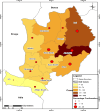Descriptive epidemiology of Lassa fever, its trend, seasonality, and mortality predictors in Ebonyi State, South- East, Nigeria, 2018-2022
- PMID: 39695525
- PMCID: PMC11658097
- DOI: 10.1186/s12889-024-20840-y
Descriptive epidemiology of Lassa fever, its trend, seasonality, and mortality predictors in Ebonyi State, South- East, Nigeria, 2018-2022
Abstract
Background: Nigeria is an epicenter for Lassa fever. Ebonyi state is located in the South-Eastern region of Nigeria where a high burden of Lassa fever has been reported. Therefore, this study was designed to assess the epidemiology of Lassa fever, its seasonality, trend, and mortality predictors in Ebonyi state, South-East, Nigeria.
Method: We analyzed data extracted from Ebonyi State Integrated Disease Surveillance and Response (IDSR) system over five years (2018-2022). A total of 1578 reported Lassa fever cases were captured in the IDSR out of which 300 were laboratory-confirmed. Data were analyzed using descriptive statistics, additive time series model, quadratic equation, and logistic regression model (α0.05). Spatial distribution of reported Lassa fever cases was conducted using Arc G.I.S.
Results: The mean age of the individuals with the reported cases of Lassa fever was 29.4 ± 17.8 years. Lassa fever showed a seasonal trend across the years. The quadratic model provided the best fit for predicting Lassa fever cumulative cases (R2 = 98.4%, P-value < 0.05). Projected cases of Lassa fever for the year 2023 were 123 in the 1st quarter, 23 in the 2nd quarter, 42 in the 3rd quarter, and 17 in the 4th quarter. The seasonality index was + 70.76, -28.42, -9.09, and -33.2 in the 1st, 2nd, 3rd, and 4th quarters respectively. The reported cases of Lassa fever followed a declining trend (slope = -0.1363). Farmers were 70% less likely to die from Lassa fever compared to those not working (aOR:0.3, CI: 0.17-0.83). The hot spots for Lassa fever were Abakaliki and Ezza Local Government Areas.
Conclusion: Although the reported Lassa fever cases followed a declining trend in Ebonyi state, there was a seasonality in the disease pattern. Being a farmer was protective against the risk of dying from Lassa fever. While efforts to eliminate and mitigate the spread of the disease in Ebonyi state should be strengthened, more attention should target the peak period of the disease.
Keywords: Ebonyi State; Lassa fever; Seasonality; Time series analysis.
© 2024. The Author(s).
Conflict of interest statement
Declarations. Ethics approval and consent to participate: Ethical approval for this study was obtained by the data originators from the Ebonyi State Ministry of Health (EBSHREC/01/04/2022–02/04/2024). Consent for publication: Not applicable. Competing interests: The authors declare no competing interests.
Figures







Similar articles
-
Descriptive epidemiology of Lassa fever in Nigeria, 2012-2017.Pan Afr Med J. 2020 Sep 3;37:15. doi: 10.11604/pamj.2020.37.15.21160. eCollection 2020. Pan Afr Med J. 2020. PMID: 33062117 Free PMC article.
-
Epidemiologic and Clinical Features of Lassa Fever Outbreak in Nigeria, January 1-May 6, 2018.Emerg Infect Dis. 2019 Jun;25(6):1066-1074. doi: 10.3201/eid2506.181035. Emerg Infect Dis. 2019. PMID: 31107222 Free PMC article.
-
Prevalence and outcome of Lassa fever among hospitalized patients in Ebonyi State, Nigeria, 2018-2019.Virus Res. 2020 Aug;285:198000. doi: 10.1016/j.virusres.2020.198000. Epub 2020 May 4. Virus Res. 2020. PMID: 32380207
-
Epidemiological trends of Lassa fever in Nigeria from 2015-2021: A review.Ther Adv Infect Dis. 2021 Nov 29;8:20499361211058252. doi: 10.1177/20499361211058252. eCollection 2021 Jan-Dec. Ther Adv Infect Dis. 2021. PMID: 34868582 Free PMC article. Review.
-
Trend of Lassa fever cases and factors associated with mortality in Liberia, 2016 - 2021: a secondary data analysis.Pan Afr Med J. 2024 Jan 19;47:22. doi: 10.11604/pamj.2024.47.22.42156. eCollection 2024. Pan Afr Med J. 2024. PMID: 38558556 Free PMC article. Review.
Cited by
-
A global living systematic review and meta-analysis hub of emerging vaccines in pregnancy and childhood.Reprod Health. 2025 Jul 18;22(1):129. doi: 10.1186/s12978-025-02090-2. Reprod Health. 2025. PMID: 40682141 Free PMC article.
References
-
- Adebowale AS, Afolabi RF, Bello S, Salawu MM, Bamgboye EA, Adeoye I, Dairo MD, Kivumbi B, Wanyana I, Seck I, Diallo I, Leye MMM, Bassoum O, Fall M, Ndejjo R, Kabwama SN, Mapatano MA, Bosonkie M, Egbende L, … Fawole OI. Spread and seasonality of COVID ‑ 19 pandemic confirmed cases in sub ‑ Saharan Africa : experience from Democratic Republic. BMC Infect Dis 2023;1–12. 10.1186/s12879-023-08168-1 - PMC - PubMed
MeSH terms
LinkOut - more resources
Full Text Sources

